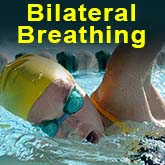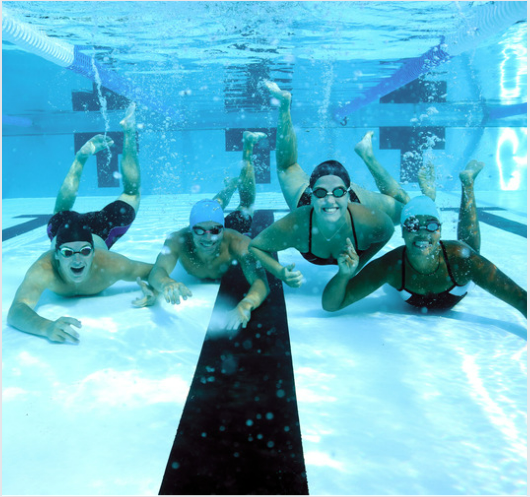Bilateral Breathing For Swimmers

Swim Tips, Drills, Swim Technique, Training
|
April 28, 2014
Q: Why should swimmers learn bilateral breathing?
A: Bilateral breathing makes you a better swimmer!
What Is Bilateral Breathing?
The term may sound like swimming snob jargon, but the meaning is actually quite simple. It means: breathing on both sides. Sit at the edge of the pool and watch athletes swimming freestyle. Chances are, you'll see 3 different styles of breathing:Bilateral breathing only applies to the Freestyle stroke, where breaths should be taken on alternating sides, commonly after every 3 strokes (a stroke is the action of one arm travelling pulling through the water). The resultant pattern looks like this:1. Breathing on one side, known as unilateral breathing. 2. Lifting the head out of the water for front breathing , known as really bad form. 3. Alternating breathing on both sides, also known as bilateral breathing.
Arm A / Arm B / Arm A (Breathe on Side A) Arm B / Arm A / Arm B (Breathe on Side B) (and repeat)
Other Bilateral Breathing variations:- Some swimmers alternate after 5 or 7 strokes.
- Some swimmers may choose to alternate repetitions of side breathing, such as this stroke pattern:
Arm A / Arm B / (Breathe on Side B) Arm A / Arm B / (Breathe on Side B) Arm A / Arm B / Arm A (Breathe on Side A) Arm B / Arm A / (Breathe on Side A) Arm B / Arm A / (Breathe on Side A) Arm B / Arm A / Arm B (Breathe on Side B) (and repeat)
Why Is Bilateral Breathing Important For Swimmers?
Breathing on both sides will help you develop a smoother, more symmetrical swim stroke by naturally encouraging proper body rotation on both sides. Swimmers that do not learn to breathe bilaterally do not rotate properly on the breathless side, causing them to overthrow their recovering arm past the center line of the body's long access while swinging back to the top of the stroke. Crossing over causes the hips to zig-zag and the body to fold, throwing the swimmer off course and wasting copious amounts of energy.When is it OK to break the bilateral breathing law and practice unilateral breathing?
Confident swimmers with well-developed technique may choose not to breath bilaterally during sprint sets in swim practice or during competition. This is fine! However, unilateral is the exception - and bilateral is the rule. Most training should be performed with bilateral breathing.Complications With Bilateral Breathing
Some swimmers give up with learning bilateral breathing because they don't feel like they're getting adequate oxygen. This discomfort is usually resolved by developing a better breathing technique, turning exhalations into a consistent, yet forceful exhale that lasts the entire time your mouth is underwater, stopping when your mouth leaves the water to take another breath. Remember to think of your underwater exhalation by picturing a constant stream of bubbles that emanate from your mouth. This will serve as a reminder not to hold your breath and cheat proper breathing.Well now you know!
So much for the swim snobbery jargon - bilateral breathing is an obtainable goal for new swimmers (and swimmers with bad habits). A few workouts using this technique is all you need to break the unilateral habit and take your swimming to a higher level.Did we leave you "breathless" and wanting more?
Read our advice on swim fin sizing and learn about the 15 meter resurfacing marker - two important topics to help you rule the pool and wipe the smirk off the faces of the old school pool fools. Please feel free to leave your questions and comments below! See you at the pool- RobinLearn More Swimming Tips:
- Swimming Tips For Beginners: Basic Gear, Pool Etiquette, and Overcoming Inertia
- Swimming Technique: 3 Ways To Improve Speed (Butterfly Edition)
- Lap Swimming Etiquette
- Swimming Technique Part Three: 3 Ways To Improve Speed (Breaststroke Edition)
- Swimming Technique Part Two: 3 Ways To Improve Speed (Backstroke Edition)
- 10 Quick Tips for Swim Sighting
- 15 Meter Resurfacing Markers – The Underwater Swimming Rule
- The Benefits of Swimming: 5 Ways Swimming Improves Your Life








Leave a Comment
Your email address will not be published. Required fields are marked *